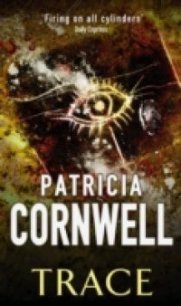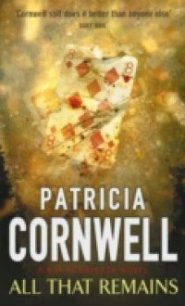Cruel and Unusual - Cornwell Patricia (читать книги без регистрации полные .txt) 📗
“Let me see if I've got this straight,” I said. “Nodes are features of barbules, barbules are features of barbs, barbs are features of feathers, and feathers are features of birds.”
“Right. And each family of birds has its own peculiar feather structure.”
What I saw on the monitor's screen looked, unremarkably, like a stick figure depiction of a weed or an insect leg. Lines were connected in segments by three dimensional triangular structures that Downey said were the nodes.
“It's the size, shape, number, and pigmentation of nodes and their placement along the barbule that are key,” he patiently explained. “For example, with starlike nodes you're dealing with pigeons, ring like nodes are chickens and turkeys, enlarged flanges with prenodal swelling are cuckoos. These” - he pointed to the screen - “are clearly triangular, so right away I know your feather is either duck or goose. Not that this should come as any great surprise. The typical origin of feathers collected in burglaries, rapes, and homicides are pillows, comforters, vests, jackets, gloves. And generally the filler in these items comprises chopped feathers and down from ducks and geese, and in cheap stuff, chickens.
“But we can definitely rule out chickens here. And I'm about to decide that your feather did not come from a goose, either.”
“Why?” I asked.
“Well, the distinction would be easy if we had a whole feather. Down is tough. But based on what I'm seeing here, there are, on average, just too few nodes. Plus; they aren't located throughout the barbule but are more distal, or located more toward the end of the barbule. And that's a characteristic of ducks.”
He opened a cabinet and slid out several drawers of slides.
“Let's see. I've got about sixty slides of ducks. To be on the safe side I'm going to run through all of them, eliminating as I go.”
One by one he placed slides under the comparison microscope, which is basically two compound microscopes combined into one binocular unit. On the video monitor was a circular field of light divided down the middle by a fine line, the known feather specimen on one side of the line and the one we hoped to identify on the other. Rapidly, we scanned mallard, Muscovy, harlequin, scoter, ruddy, and American widgeon, and then dozens more. Downey did not have to look long at any one of them to know that the duck we sought was being elusive.
“Am I just imagining it, or is this one more delicate than the others?” I said of the feather in question.
“You're not imagining it. It's more delicate, more streamlined. See how the triangular structures don't flare out quite as much?”
“Okay. Now that you've pointed it out.”
“And this is giving us an important hint about the bird. That's what's fascinating. Nature really does have a reason for things, and I'm suspicious that in this case the reason is insulation. The purpose of down is to trap air, and the finer the barbules, the more streamlined or tapered the nodes, and the more distal the location of the nodes, the more efficient the down is going to be at trapping air. When air's trapped or dead, it's like being in a small, insulated room with no ventilation. You're going to be warm.”
He placed another slide on the microscope's stage, and this time I could see that we were close. The barbules were delicate, the nodes tapered and distally located.
“What have we got?” I asked.
“I've saved the prime suspects for last.”
He looked pleased. “Sea ducks. And top in the lineup are the eiders. Let's bump the magnification up to four hundred.”
He switched the objective lens, adjusted the focus, and off we went through several more slides. “Not the king or the spectacle. And I don't think it's the stellar because of the brownish pigmentation at the base of the node. Your feather doesn't have that, see?”
“I see.”
“So we'll try the common eider. Okay. There's consistency in pigmentation,” he said, staring intensely at the screen. “And, let's see, an average of two nodes located distally along the barbules. Plus, the streamlining for extra good insulating quality - and that's important if you're swimming around in the Arctic Ocean. I think this is it, the Somateria mollissima, typically found in Iceland, Norway, Alaska, and the Siberian shores. I'll run another check with SEM, “ he added, referring to scanning electron microscopy.
“To scan for what?”
“Salt crystals.”
“Of course,” I said, fascinated. “Because eider ducks are saltwater birds.”
“Exactly. And interesting ones at that, a noteworthy example of exploitation. In Iceland and Norway, their breeding colonies are protected from predators and other disruptions so that people can collect the down with which the female lines her nest and covers her eggs. The down is then cleaned and sold to manufacturers.”
“Manufacturers of what?”
“Typically, sleeping bags and comforters.”
As he talked, he was mounting several downy barbs from the feather found inside Susan Story's car.
“Jennifer Deighton had nothing like that in her house,” I said. “Nothing filled with feathers at all.”
“Then we're probably dealing with a secondary or tertiary transfer in which the feather got transferred to the killer who in turn transferred it to his victim. You know, this is very interesting.”
The specimen was on the monitor now.
“Eider duck again,” I said.
“I think so. Let's try the slide. This is from the boy?”
“Yes,” I said. “From an adhesive residue on Eddie Heath's wrists.”
“I'll be damned.”
The microscopic debris showed up on the monitor as a fascinating variety of colors, shapes, fibers, and the familiar barbules and triangular nodes.
“Well, that puts a pretty big hole in my personal theory,” Downey said. “If we're talking about three homicides that occurred at different locations and at different times.”
“That's what we're talking about.”
“If just one of these feathers was eider duck, then I'd be tempted to consider the possibility that it was a contaminant. You know, you see these labels that say one hundred percent acrylic and it turns out to be ninety percent acrylic and ten percent nylon. Labels lie. If the run before your acrylic sweater, for example, was a lot of nylon jackets, then the very first sweaters that come off afterward will have nylon contaminants. As you run more sweaters through, the contaminant is dissipated.”
“In other words, “ I said, “if somebody is wearing a down-filled jacket or owns a comforter that got eider contaminants in it when it was manufactured, then the probability is almost nonexistent that this individual's jacket or comforter would be leaking only the eiderdown contaminants.”
“Precisely. So we'll assume the item in question is filled with pure eiderdown, and that is extremely curious. Usually what I'm going to see in cases that come through here are your Kmart-variety jackets, gloves, or comforters filled with chicken feathers or maybe goose. Eider is a specialty item, a very exclusive shop item. A vest, jacket, comforter, or sleeping bag filled with eiderdown is going to have very low leakage, be very well made - and prohibitively expensive.”
“Have you ever had eiderdown submitted as evidence before?”
“This is the first.”
“Why is it so valuable?”
“The insulating qualities I've already described. But aesthetic appeal also has a lot to do with it. The common eider's down is snow-white. Most down is dingy.”
“And if I purchased a specialty item filled with eiderdown, would I be aware that it's filled with this snow-white down or would the label simply say 'duck down'?’
“I'm quite sure you'd be aware of it,” he said. “The label would probably say something like 'one hundred percent eiderdown.’
There would have to be something that would justify the price.”
“Can you run a computer check on down distributors?”



